Table of content
Internet of Things - IoT is taking over the world like never before. That includes everything from the smart speakers in our rooms, AI-based gadgets, and interactive kiosks at the food courts. For a business to gain customers’ attention in such an environment is undoubtedly a challenging task and an opportunity.
The primary question businesses need to ask themselves are:
- How can we effectively distribute our content in front of the right audience, at the right time, and on a suitable device, amidst the multitude of diverse variables in action?
- Apart from that, what is the most effective way to scale the content marketing and advertising strategy to reach more devices and touchpoints?
This is where the role of headless content management comes into play. A headless CMS is based on a modular architecture that decouples content creation, management, and publishing from how it’s displayed. It allows marketing and editorial teams to publish new content and developers teams to make new tech updates without depending on the other for help or worrying about blocking any process.
Application programming interface (API) technology allows content modules to be quickly optimized and distributed on various channels like websites, mobile applications, intelligent gadgets, digital billboards, kiosks, chatbot knowledge bases, and every other modern consumer channel.

Headless CMS is part of the MACH methodology. MACH methodology is based on four fundamental principles:
- Flexible Microservices to deliver state-of-the-art functionality
- APIs for infinite flexibility,
- Cloud for affordability and scalability
- The Headless approach so that it can function without hurdles on any platform.
Businesses and enterprises can use the fundamental theme of any front-end utility (API) they want to present the content. They can enjoy the freedom of delivering content beyond websites and apps to any medium, from digital kiosks to smartwatches and VR headsets.
Top 20 Headless CMS to use in 2022
1. Butter CMS

Butter CMS is a Chicago-based, API-first CMS that was introduced in 2014. Salient Features of Butter CMS include:
- Custom page types
- Relational content modeling
- Webhooks
- CDN support
- Multi-site support
- Testing emulator
- Customizable Admin interface
Butter CMS provides an ecosystem for independent blogging that you can integrate into any framework.For marketers, Butter CMS provides a What You See Is What You Get (WYSIWYG) interface to support the development of SEO landing pages, customer case studies, news pages, etc.
Variants:
- Free trial version
- Premium Plan
- Enterprise plan
2. Contentstack

San Francisco-based Contentstack was introduced in 2007, is a headless CMS that provides RESTful APIs. Its rich Features include:
- Content previews
- Collaboration
- Asset management
- Workflow management
- Versioning.
Turnkey integrations for utilities such as Marketo, Salesforce, and Eloqua, also come available.
Variants:
- Free trial version
- Premium Plan
- Enterprise plan
3. Contentful
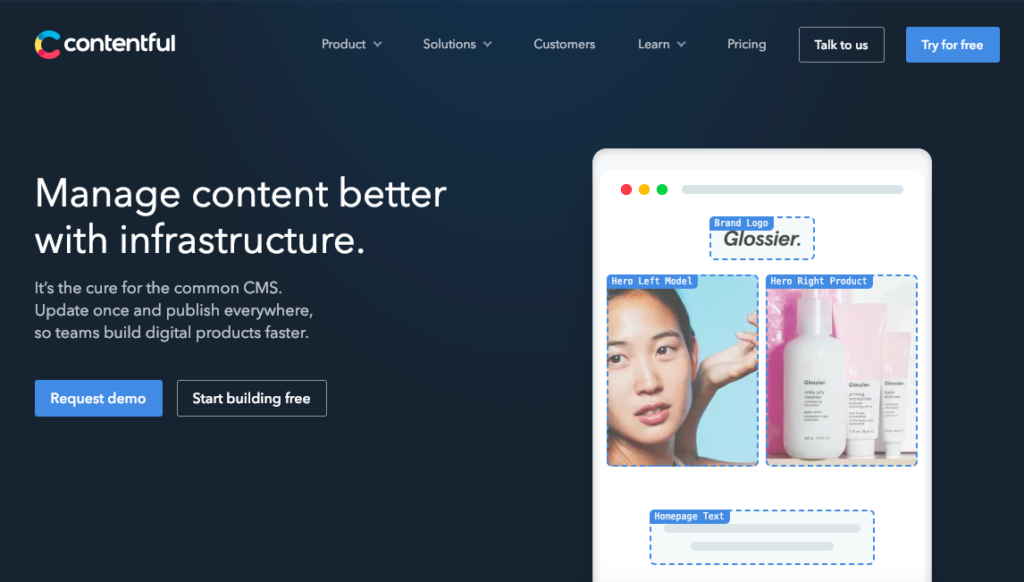
Introduced in 2013 by a German-based company, Contentful offers an API-based headless CMS. Contentful’s RESTful API allows developers complete control over content, digital assets, and translations. The platform leverages caching techniques and external CDN integrations to allow the distribution of API payloads in the sub-100ms range.It can showcase JSON snippets, a rich-text editor, and its content modeling features allow marketers to outline and separate individual fields and content modules such as text, images, and calendars.
Variants:
- Free trial version
- Premium Plan
- Enterprise plan
4. dotCMS
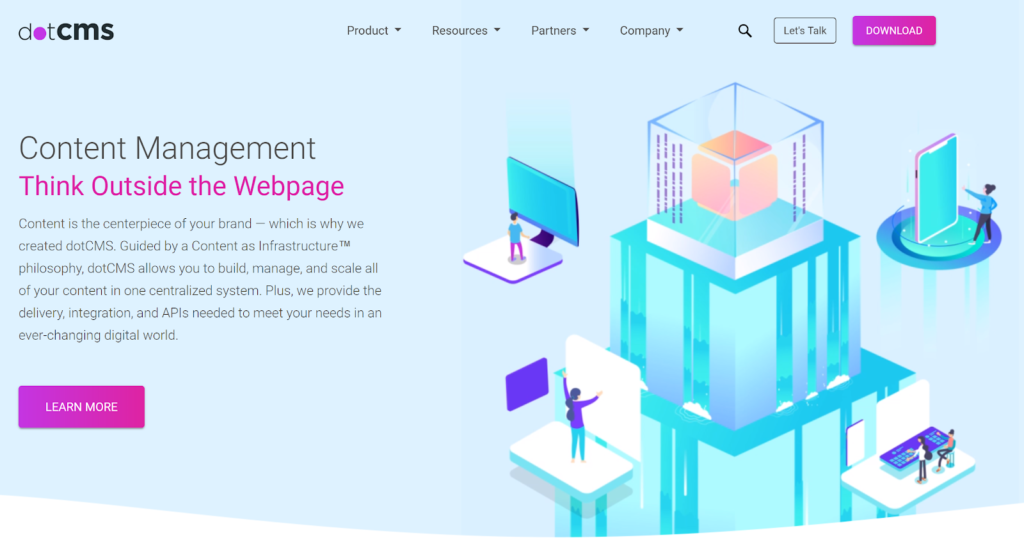
DotCMS is an open-source headless CMS introduced by a Florida-based tech company in 2003. DotCMS is not a new name in the world of content management. Their Java CMS ensures multilingual and multi-tenant capabilities parallel with a WYSIWYG interface and drag-and-drop tools that allow non-technical individuals like marketers to effectively interact with content modeling platforms, develop workflows, and modify their page layout. DotCMS can be hosted either on-premise or in the cloud. The platform provides features like:
- Analytics dashboard
- Customization tools
- Custom endpoint building
- Support for 3rd party tools like AWS, Docker, Salesforce, etc.
Variants:
- Free trial version
- Premium Plan
- Enterprise plan
5. Mura

California-based Mura is an open-source decoupled CMS that comes with plenty of features for marketers and IT experts to capitalize on. It is recommended to explore a highly customizable WYSIWYG editing interface, custom navigation creator, multi-device content previews, and an integrated analytics dashboard for marketers. Developers enjoy the perks of APIs, Docker support, CSS framework utility, and support for renowned JavaScript frameworks such as Vue.js, React.js., & Ember.js.
Variants:
- Free Version Available
6. Cockpit CMS

It is a free, open-source, and self-hosted headless CMS introduced by Germany. Cockpit declares itself a “content provider,” not a website developer, as it is a backend utility that holds and distributes content across multiple channels. The lack of editing utilities to alter the presentation of your content is what makes it a dedicated headless CMS.The platform depends on APIs and JSON to deliver and showcase the content.
Variants: Free and Open Source
7. Core DNA

The Boston-based company introduced Core DNA as a headless CMS platform that comprises around 80 different applications that assist digital experience management, eCommerce, and intranets.
With a rich multi-tenant and decoupled structure, the SaaS platform offers features such as:
- Personalization
- Multi-site management
- Localization
- Integrations
- Framework agnosticism
- Comprehensive inventory management.
The platform also offers a WYSIWYG editing interface to support rich text and media management.
Variants:
- Premium Plan
- Enterprise plan
8. Craft CMS
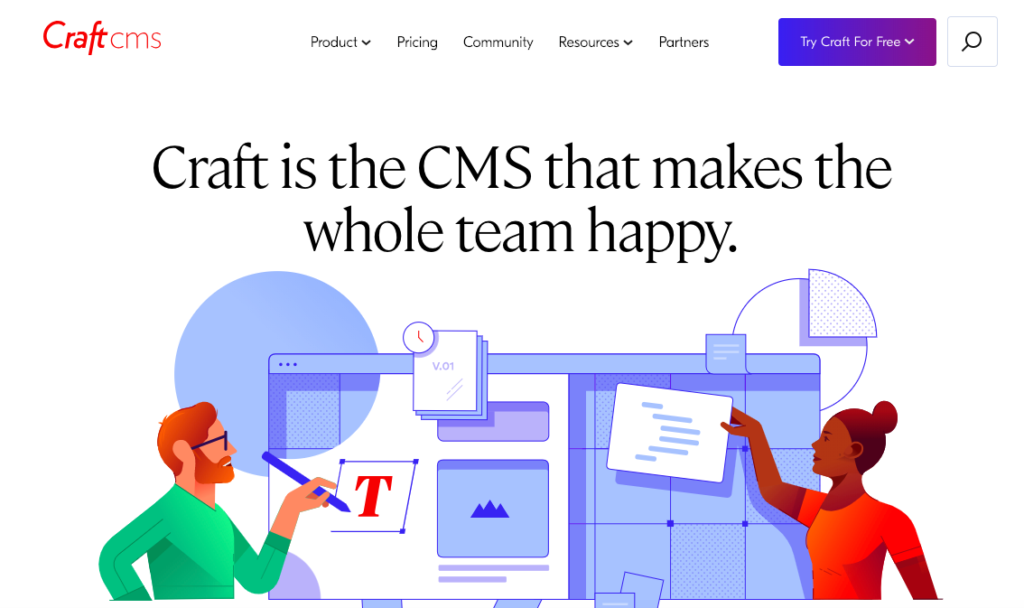
In 2013, Craft CMS was a Bend OR-based “content-first” headless CMS that allows users to manipulate experiences throughout their content.
Craft CMS provides features like:
- Custom fields
- Drag-and-drop layout management
- Multi-site management
- Localization
- Asset management
- Live content previews
- Built-in image editor.
Each user maintains their own customizable and highly visual dashboards.
Variants:
- Free Version
- Premium Plan
- Enterprise plan
9. Zesty.io

Zesty.io is a San Diego-based headless CMS that provides utilities for both marketers and developers.
For marketers, Zesty.io offers features like:
- Template and page building
- Workflow management
- Automated SEO
- Advanced SEO tools
- Tools to launch microsites and landing pages
For developers, Zesty.io provides:
- content-aware templating
- Custom endpoint building
- Built-in staging environments
- Customizable content models to support headless JSON APIs.
Variants:
- Enterprise plans Available
10. Directus
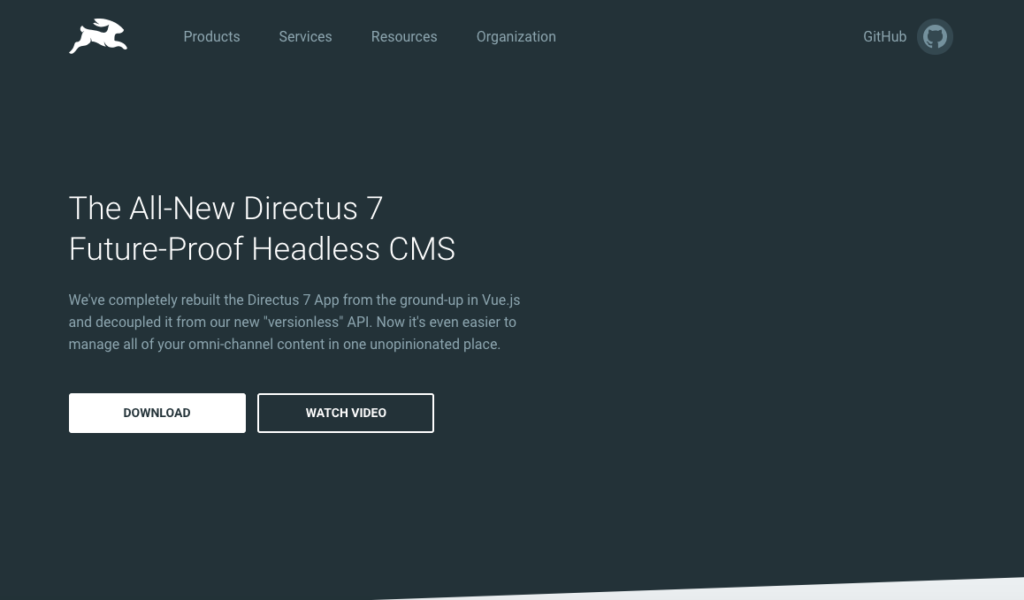
New York-based Directus is an open-source headless CMS and API tool. Using Vue.js., Directus effectively handles custom-schema SQL databases. The theme behind Directus is that developers can develop custom databases per specific project needs without having any prerequisite skill of working with a framework or any other IT skill. Once the database is prepared, Directus’ API or SDKs can be integrated. The outcome is a customizable and interactive interface that allows business users to manage database content for their websites and applications.
Variants:
- Free trial version
- Premium Plan
- Enterprise plan
11. DatoCMS
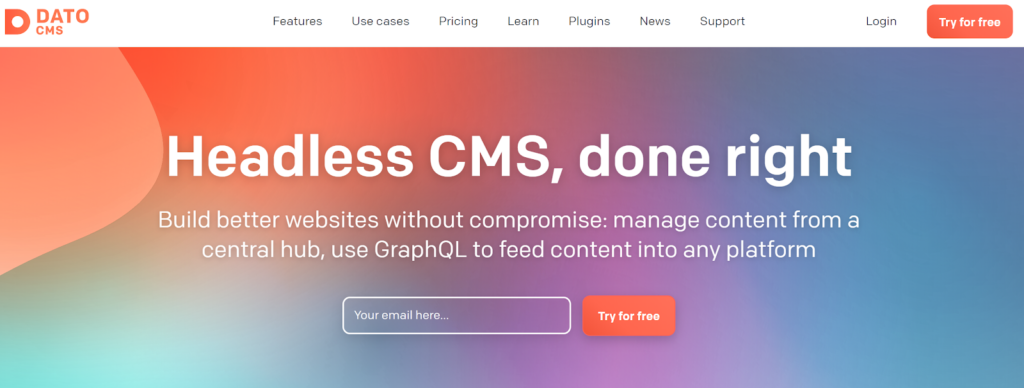
DatoCMS is an Italian headless content as a service (CaaS) utility that supports multiple languages. By doing so, DatoCMS enables brands to:
- Organize digital assets in separate folders
- Locate media files quickly using AI-based tagging and search utilities
- Publish content wherever required
Variants:
- Free Version Available
12. GraphCMS
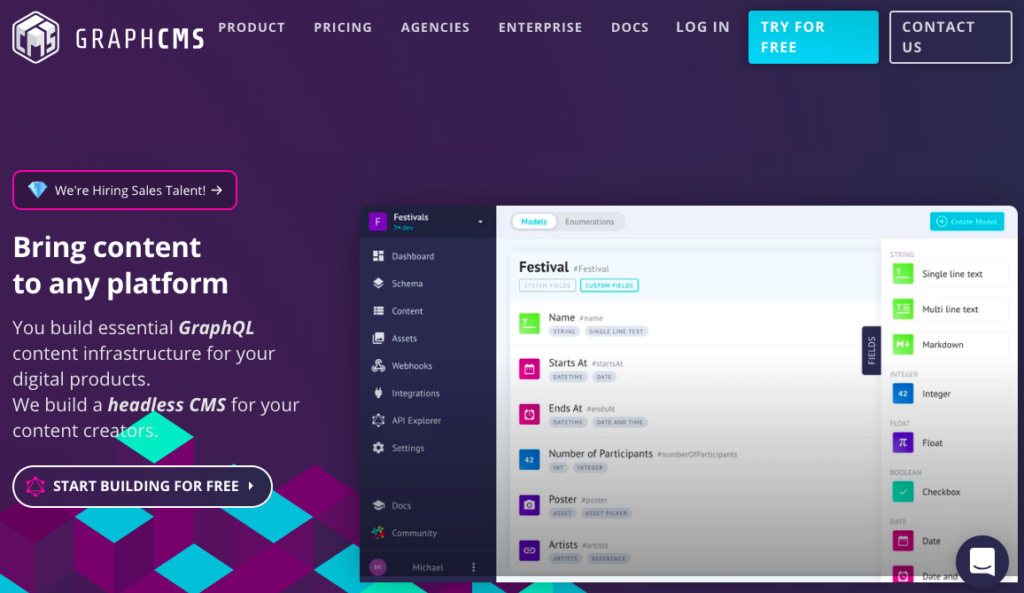
It is a Germany-based API-first CMS that was introduced in 2017. The platform is based on GraphQL, a data query language that, according to some experts, is the successor to REST. GraphCMS enables developers to create a hosted GraphQL backend for their application that provides the liberty of defining relations, structures, and authorizations for the app data. It also comes with several utilities to create and effectively handle the content, including:
- Text editors
- Asset management
- Workflows
- User roles
- Multilingual support.
Variants:
- Free trial version
- Premium Plan
- Enterprise plan
13. Cosmic JS

Cosmic JS is a cloud-hosted headless CMS platform that provides both RESTful and GraphQL APIs. The platform provides features like:
- Content modeling
- Localization
- Webhooks
- Media management
- WYSIWYG editing interface
- Support for third-party utilities like GitHub and Typeform.
The CMS supports integration with Slack, AWS, Stripe, HubSpot, and Algolia.
Variants:
- Free Community version
- Premium Plan
14. Kontent.ai (Kentico)

Kentico Cloud, marketed as Kontent.ai, is a Czech Republic-based SaaS headless CMS that enables developers to integrate existing technologies and develop sites using the languages, methodologies, utilities, and frameworks. It also offers several SDKs, secured access to API, and SLA-promised uptime. As far as content creation is concerned, Kentico Cloud provides a WYSIWYG interface and enables editors to collaborate, manage workflow, design content layout, customize different aspects of the process, and localization.
Variants:
- Free trial version
- Premium Plan
- Enterprise plan
15. Prismic.io

US-based Prismic is a SaaS headless CMS that offers:
- Visual editor
- Custom type builds
- Multi-language support
- Full revision history.
- Native integrations with top eCommerce platforms like Shopify and Magento
Prismic also provides scheduling options and project management utilities to ensure collaboration and intelligent workflow management. It provides developers rich development kit for their desired programming language or framework.
Variants:
- Free version
- Premium Plan
- Enterprise plan
16. Bold (Quintype)

Founded in 2014, an Indian platform, Quintype is an API-based headless CMS intended to serve digital media organizations and news media outlets. Quintype’s interactive editing interface allows:
- Collaborative content generation
- Rich features to manage workflow effectively
- Automated publishing
- Support for both multilingual and multi-format content.
Quintype’s CMS engine also provides features like:
- Engagement tracking
- Dashboard for Real-time analytics
- Automated daily reports
- Author performance indicators
Quintype’s “auto-scaling infrastructure” provides support for Facebook blogs, Googe AMP, content syndication as well as push notifications.
Variants:
- Free version
- Enterprise plan
17. Sanity

Introduced in 2015, Sanity is a Norway-based, state-of-the-art open-source headless CMS Oslo. Built on JavaScript and React.js, Sanity provides an interactive WYSIWYG editing interface that enables users to embed editable data in existing content. It also offers a Sweet Query API that allows processing multiple queries on a single request.Sanity richly provides:
- Real-time collaboration
- Live to preview
- Content versioning.
Variants:
- Free version
- Premium Plan
- Enterprise plan
18. Scrivito

Scrivito was introduced by Germany, a headless CMS that supports AWS, JavaScript, and ReactJS. Its rich features include:
- WYSIWYG drag-and-drop editing interface
- User permissions
- Collaboration
- Client-side rendering
- CDN support
- Dynamic Image Resizing
Variants:
- Free trial version
- Premium Plan
- Enterprise plan
19. Sitecore

US-based Sitecore is regarded as a WCM industry leader by Gartner. The enterprise variant of this platform provides:
- Sitecore Experience Platform
- Content Hub
- Experience Manager
- Experience Commerce
- In-context editing and designing
- Cross-channel preview
- Enterprise-class search
- Asset management
- Content targeting
Variants:
- Demo available on request
20. DNN Evoq Content

Evoq Content is the open-source headless CMS that provides various features favorable for both marketing and IT operations. Marketers can leverage upon features like:
- WYSIWYG editing interface
- Inline image editing
- Content layout module
- Liquid Content (To allow content flow to any medium or device, in a traditional headless manner)
For developers, it provides utilities like
- Module creator
- Built-in JavaScript libraries
- Dot NET API
Variants:
- Free trial version
- Premium Plan
- Enterprise plan
How can you choose the right headless CMS?
There is a multitude of options that makes it challenging to navigate through the ocean of features. We think it’s best to focus on a CMS that allows you to thrive and is highly adaptable and scalable as per your requirements. Below is the list of questions you need to ponder over to evaluate your choice effectively.
- Is it possible to develop the kinds of content structures you need to?
- Is it necessary to look after content hosting and maintenance all by yourself?
- Will your content be stored securely and privately?
- Would real-time editing and collaboration improve your workflows?
- Will your comprehensive text content be locked to HTML?
- Can you scale your content operations without spending extra money?
- What is the procedure for managing files and images?
Headless API Types
To better evaluate the value of a headless CMS, it’s mandatory to know more about APIs. API stands for Application Programming Interface. In the given context, it means you get content in a way that is simpler to integrate with existing or new software utilities. Typically, you do this by sending the headless CMS a network request to an API end node. This network request is much more the same thing you do while visiting a webpage, but instead of a web page, you get a list of the backend of the content.
While using this information to develop software using a programming approach with APIs, most Developers prefer them because it provides them complete control of how to develop their application. Some CMSes also allow you to change content using APIs. API is a broad area that goes beyond the domain of CMSes and the World Wide Web. Therefore, exploring the two frequently-used APIs is recommended when we talk about content management, namely REST and GraphQL.
What is REST API?
APIs can be more or less scalable when it comes to developing applications on top of them. In mainstream practice, Headless CMSes have offered REST APIs. They outline the content behind multiple URLs such as posts, authors, or images. Developers have to deal with multiple requests with the IDs of the variety of content types together. REST APIs can be effective for simple data structures, but this approach can be time-consuming if your content models are more complex. It requires more effort to change or mold these APIs for different purposes.
What is GraphQL?
Facebook introduced GraphQL as an alternative to the less flexible REST approach. It allows you to query the API with the fields and relationships you require for each event. This is exactly how you interact with the databases. It also makes it simple to introduce new fields and content types as your system grows horizontally. The reason to choose more flexible and scalable APIs is to eliminate the hurdles to reuse content across different channels.
End Words
Going headless or transitioning from an old-school content management methodology to an advanced one will likely be an overwhelming task. Still, it’ll save both your time and money if you opt for the right headless CMS platform per your feasibility and priorities.



